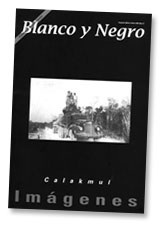Marilyn Domínguez Turriza
INAH Center
(National Institute of Anthropology and History)
Campeche
Juan Carlos Saucedo Villegas
Institute of Culture
A brief history of photography in Campeche.
Photography has been a part of everyday life and been accepted by all social classes since its very beginning, thus it has become a means of expression of society. Photography is a valuable source of information and is considered a social document, since it allows the reconstruction of the past.
Photography has been a part of Campeche since the 19th Century, however it has not been deemed as historically, socially or politically important and in a number of occasions it has been considered as a useless, low-value object. Photography arrived to Campeche in early 1840, just a few years after its invention. The German Baron Emmanuel of Frierichstal arrived to the Yucatan peninsula and obtained images of the Mayan ruins with a camera Lucida, but he also made some portraits with daguerreotype plates in the cities of Campeche and Merida. Other foreign photographers that arrived to the peninsula were John Lloyd Stephens, Frederich Catherwood and Desiree Charney. |
Click to enlarge |
The local press of the 19th Century has records of getting the services of traveling photographers that would stay in Campeche for a few days.
In the edition of January 28th, 1847 of Amigo Del Pueblo, Ricardo Carr announces that he has brought with him the latest invention from Europe to make the most accurate portraits with or without color, either of a single person or a group using the same plate. All copies are guaranteed to be exactly as the original and to be entirely satisfactory and he will be happy to show samples of pictures and frames to any visitor to his studio, the price of each photograph is 5 Pesos.
We cannot tell which was the first photographic studio established in Campeche, some say it was Manuel Rejon’s, later property of Joaquin Hernandez. At any rate, the constant presence of traveling photographers demonstrates the interest of the locals in the new art or science of capturing reality.
|
Workers
of the Carpizo Hacienda in Champoton, Campeche, circa 1930. |
The Municipal Archive of Campeche has over 600 photographs taken between 1880 and 1950, which were obtained through the collaboration of the local people, who responded enthusiastically to the call for images of the two ancient family portrait contests organized by the authorities. There are images of landscapes, architecture, political life, society, everyday life, fairs, carnivals and portraits, mainly within the city and port of Campeche.
|
Soledad
and Ángela Uc Collí, Calkiní, Campeche, circa.
1928-30. |
|
Mr.
Valentin Uc teaching children how to make hats in a cave in Bécal,
Calkiní 1937. |
After the family photos, the postcards made in the late 19th and early 20th Centuries are perhaps the most appreciated in Mexico. In the case of Campeche we can mention the ones made by Cicero & Perez, and Ernesto Aznar Preciat, in Ciudad del Carmen, Juan B. Caldera, postcards from another towns are available.
There are hundredths of family photos that are not officially archived or registered, but in recent years, The National Anthropology Institute via its Campeche center, has taken to collect these images that include views of towns and cities and everyday life scenes.
Historian Gaspar Cahuich mentions that Francisco C. Cicero, descendent of one of the first families to establish in Mexico during the Spanish Colony in 1654, lived in Campeche in 1910.
Cicero & Perez owned several buildings in downtown Campeche, among them, a store in front of the park, “La Estrella” that sold the postcards.
These postcards, made between 1910 and 1920, are the fruit of the work of Mr. Cicero who climbed to the rooftops to take unforgettable images of old Campeche that included everything he considered to be representative of the town: churches, the waterfront, shrines, markets, slaughterhouses, etc.
Cicero’s efforts to record old Campeche have had a big pay off. Many families keep those old postcards, which are still reproduced today and framed to be hung in living rooms or business offices or to illustrate a magazine or be part of an exhibition.





